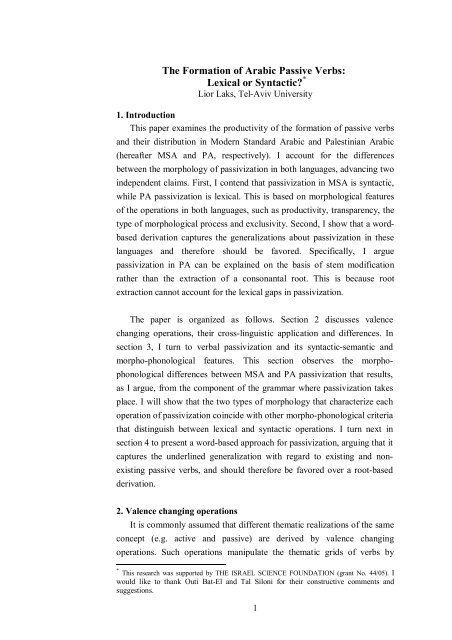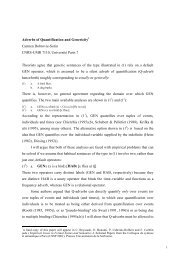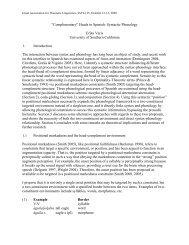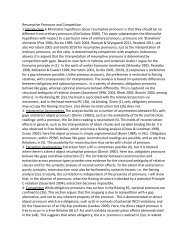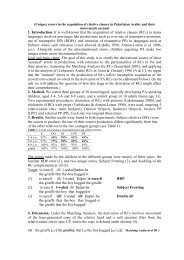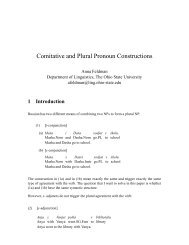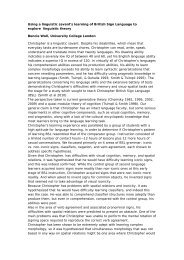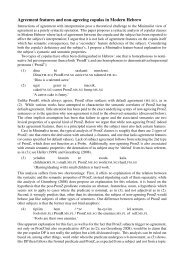The Formation of Arabic Passive Verbs - Generative Linguistics
The Formation of Arabic Passive Verbs - Generative Linguistics
The Formation of Arabic Passive Verbs - Generative Linguistics
You also want an ePaper? Increase the reach of your titles
YUMPU automatically turns print PDFs into web optimized ePapers that Google loves.
<strong>The</strong> <strong>Formation</strong> <strong>of</strong> <strong>Arabic</strong> <strong>Passive</strong> <strong>Verbs</strong>:<br />
Lexical or Syntactic *<br />
Lior Laks, Tel-Aviv University<br />
1. Introduction<br />
This paper examines the productivity <strong>of</strong> the formation <strong>of</strong> passive verbs<br />
and their distribution in Modern Standard <strong>Arabic</strong> and Palestinian <strong>Arabic</strong><br />
(hereafter MSA and PA, respectively). I account for the differences<br />
between the morphology <strong>of</strong> passivization in both languages, advancing two<br />
independent claims. First, I contend that passivization in MSA is syntactic,<br />
while PA passivization is lexical. This is based on morphological features<br />
<strong>of</strong> the operations in both languages, such as productivity, transparency, the<br />
type <strong>of</strong> morphological process and exclusivity. Second, I show that a wordbased<br />
derivation captures the generalizations about passivization in these<br />
languages and therefore should be favored. Specifically, I argue<br />
passivization in PA can be explained on the basis <strong>of</strong> stem modification<br />
rather than the extraction <strong>of</strong> a consonantal root. This is because root<br />
extraction cannot account for the lexical gaps in passivization.<br />
<strong>The</strong> paper is organized as follows. Section 2 discusses valence<br />
changing operations, their cross-linguistic application and differences. In<br />
section 3, I turn to verbal passivization and its syntactic-semantic and<br />
morpho-phonological features. This section observes the morphophonological<br />
differences between MSA and PA passivization that results,<br />
as I argue, from the component <strong>of</strong> the grammar where passivization takes<br />
place. I will show that the two types <strong>of</strong> morphology that characterize each<br />
operation <strong>of</strong> passivization coincide with other morpho-phonological criteria<br />
that distinguish between lexical and syntactic operations. I turn next in<br />
section 4 to present a word-based approach for passivization, arguing that it<br />
captures the underlined generalization with regard to existing and nonexisting<br />
passive verbs, and should therefore be favored over a root-based<br />
derivation.<br />
2. Valence changing operations<br />
It is commonly assumed that different thematic realizations <strong>of</strong> the same<br />
concept (e.g. active and passive) are derived by valence changing<br />
operations. Such operations manipulate the thematic grids <strong>of</strong> verbs by<br />
* This research was supported by THE ISRAEL SCIENCE FOUNDATION (grant No. 44/05). I<br />
would like to thank Outi Bat-El and Tal Siloni for their constructive comments and<br />
suggestions.<br />
1
adding or reducing thematic roles, yielding predicates such as passive,<br />
causative and reciprocal verbs. While valence changing operations apply<br />
cross-linguistically, languages demonstrate various differences with regard<br />
to operations such as reflexivization (Reinhart & Siloni 2005, Horvath &<br />
Siloni 2005, 2008, Siloni 2005). Reinhart & Siloni (2005) suggest that<br />
thematic operations, which affect the syntactic valence <strong>of</strong> a verb, are<br />
allowed to apply in the lexicon or in the syntax, as formulated in the<br />
following parameter.<br />
(1) <strong>The</strong> Lex-Syn Parameter (Reinhart & Siloni 2005)<br />
UG allows thematic operations to apply in the lexicon or in the<br />
syntax.<br />
<strong>The</strong>re are languages such as Hebrew and Hungarian whose parameter is<br />
set to ‘lexicon’, while there are languages such as French and Romanian,<br />
whose parameter is set to ‘syntax’. <strong>The</strong> differences between such languages<br />
are manifested in syntactic-semantic features. In this framework, the<br />
grammar includes an active lexicon (Levin and Rappaport Hovav 1994,<br />
1995, Reinhart 2002, Siloni 2002), which is more than a mere list <strong>of</strong> items,<br />
and allows the application <strong>of</strong> derivational operations. <strong>The</strong> lexicon is<br />
regarded as an interface between the conceptual system and the<br />
computational system. From the thematic point <strong>of</strong> view, it contains coded<br />
concepts, along with their thematic grids, and it functions as a<br />
computational component, which can perform valence changing operations<br />
pre-syntactically.<br />
<strong>The</strong>matic operations usually result in at least two related verbs. <strong>The</strong>se<br />
realizations are mostly morphologically distinct (e.g. katab ‘write’ and<br />
inkatab ‘be written’ in PA). That is, valence changing operations are, to a<br />
large extent, manifested in morphological processes. Such related verbs in<br />
MSA and PA share the same consonants and are represented in different<br />
prosodic templates. Each template indicates the phonological shape <strong>of</strong> the<br />
verb, i.e. its vowels, its prosodic structure and its affixes (if any). <strong>The</strong><br />
phonological shape <strong>of</strong> a verb is essential for determining the shape <strong>of</strong> other<br />
forms in the inflectional paradigm (Berman 1978, Bolozky 1978, Bat-El<br />
1989, Aron<strong>of</strong>f 1994). <strong>The</strong> possible prosodic templates in MSA and PA are<br />
demonstrated in (2) and (3) respectively.<br />
2
(2) MSA Prosodic Templates 1<br />
Perfect Imperfect<br />
faal ya-fa/i/ul<br />
faal yu-fail<br />
faaal yu-faail<br />
afal yu-fil<br />
tafaal ya-tafaal<br />
tafaaal ya-tafaaal<br />
infaal ya-nfail<br />
iftaal ya-ftail<br />
istafal ya-stafil<br />
(3) PA Prosodic Templates<br />
Perfect Imperfect<br />
faal yi-fa/i/ul<br />
faal yi-fael<br />
faaal yi-faael<br />
afal yu-fil<br />
tfaal ya-tfaal<br />
tfaaal ya-tfaaal<br />
infaal ya-nfail<br />
iftaal ya-ftail<br />
istafal ya-stafil<br />
3. Verbal passivization<br />
Passivization involves an operation labeled saturation, which saturates<br />
the external theta role by existential closure (Chierchia 1989/2004,<br />
Reinhart and Siloni 2005). <strong>The</strong> theta role is assigned to a variable bound by<br />
an existential operator. <strong>The</strong> external argument is no longer syntactically<br />
accessible, but it is still accessible on the level <strong>of</strong> interpretation.<br />
Passivization applies to predicates that bear both an external and an<br />
internal theta role. <strong>The</strong> passive verb loses the ability to assign an accusative<br />
case, and the internal argument moves to the subject position to receive a<br />
case. Passivization does not include manipulation <strong>of</strong> the theta grid. Horvath<br />
and Siloni (2005, 2006, 2008) provide evidence that verbal passivization is<br />
syntactic. <strong>The</strong>y base their argument on features such as semantic drifts,<br />
nominalizations and idioms. I argue that while this is the case in MSA<br />
passivization, PA passivization applies in the lexicon. I argue that the Lex-<br />
Syn parameter has morpho-phonological consequences as well (Laks 2006,<br />
2007); once the parameter value is set, a cluster <strong>of</strong> three morphophonological<br />
properties follows.<br />
I will show morpho-phonological<br />
1 This does not include inflectional pronoun suffixes, which are concatenated to the stem<br />
for agreement purposes.<br />
3
evidence that PA passivization demonstrates similar morphological<br />
features that are also shared by other thematic operations such as<br />
reflexivization and reciprocalization.<br />
3.1. MSA passivization<br />
Passivization applies productively in MSA. It is possible to form a<br />
passive counterpart for each transitive verb. Passivization is performed by<br />
melodic overwriting, in which the vocalic pattern <strong>of</strong> a transitive verb<br />
changes into u-i and u-a in the perfective (4a) and imperfective (4b) forms<br />
respectively.<br />
(4) MSA Passivization<br />
Base Derived Form<br />
a. Perfective form<br />
kasar kusir ‘broke’<br />
saaad suuid ‘helped’<br />
arsal ursil ‘sent’<br />
tanaawal tunuuwil ‘handled’<br />
intaxab untuxib ‘elected’<br />
istaqbal ustuqbil ‘met’<br />
b. Imperfective form<br />
yaksur yuksar ‘break’<br />
yusaaid yusaaad ‘help’<br />
yursil yursal ‘send’<br />
yatanaawal yutanaawal ‘handle’<br />
yantaxib yuntaxab ‘elect’<br />
yastaqbil yustaqbal ‘meet’<br />
When the verb exceeds the minimal word size (a binary foot), one <strong>of</strong> the<br />
vowels <strong>of</strong> the passive pattern spreads to the rest <strong>of</strong> the syllables. In the<br />
perfective form, the last vowel <strong>of</strong> the stem changes to /i/ and the preceding<br />
one to /u/. <strong>The</strong> /u/ spreads to the preceding syllable (5).<br />
(5) MSA perfective forms: Melodic Overwriting<br />
u i<br />
is taq bal ‘met’ ustuqbil ‘was met’<br />
In the imperfective form, the first vowel turns into /u/ and the second<br />
one into /a/ which spreads to the rest <strong>of</strong> the word (6).<br />
(6) MSA imperfective forms: Melodic Overwriting<br />
u<br />
a<br />
yas taq bil ‘meet’ yustaqbal ‘is met’<br />
4
MSA passivization has several morpho-phonological features that coincide<br />
with the type <strong>of</strong> morpho-phonology that applies in the syntax.<br />
3.1.1. Types <strong>of</strong> morphological processes<br />
<strong>The</strong> relations between active predicates and their passive counterparts<br />
exhibit only melodic overwriting; the prosodic structure in both forms is<br />
identical and thus vacuously assigned. Melodic overwriting does not<br />
involve reference to the consonantal root (Bat El 2002) as it operates<br />
directly on the stem. Melodic overwriting applies to the segmental level<br />
only. It involves changing the quality <strong>of</strong> the stem vowels without changing<br />
the stem's prosodic shape and is therefore considered less intrusive. Other<br />
thematic operations in MSA such as decausativization, reflexivization and<br />
reciprocalization have different morphological manifestations. <strong>The</strong>se<br />
operations are performed by more intrusive processes that manipulate the<br />
prosodic structure <strong>of</strong> the base by changing either the number <strong>of</strong> syllables or<br />
their structure. Other derived predicates in MSA are formed by either<br />
adding a prefix in the formation <strong>of</strong> a reflexive (7a) or a reciprocal verb (7b),<br />
or by gemination 4(7c,d) in the formation <strong>of</strong> causative verbs (7c,d). In both<br />
cases the prosodic structure <strong>of</strong> the base does not remain intact.<br />
(7) Lexical operations in MSA<br />
Base<br />
Derived form<br />
a. maššat' ‘comb’ maššat' ‘comb oneself’<br />
b. kaatab ‘correspond with’ takaatab ‘correspond with each other’<br />
c. raqas' ‘dance’ raqqas' ‘make X dance’<br />
d. ћamal ‘carry’ ћammal ‘make X carry’<br />
3.1.2. High productivity<br />
<strong>The</strong> formation <strong>of</strong> MSA passive verbs is exception free and regarded as<br />
syntactic (Horvath and Siloni 2005, Laks 2007a,b). <strong>The</strong>re are no morphophonological,<br />
syntactic or semantic constraints that block passivization and<br />
passive verbs can be formed from any transitive verb, regardless <strong>of</strong> its<br />
template. <strong>The</strong> morphological component <strong>of</strong> the grammar is ‘blind’ with<br />
regard to the template <strong>of</strong> transitive active verbs. It is a free mechanism that<br />
can take any transitive verb, change its vowels and form a passive<br />
counterpart. This transparent and non-conditioned formation is typical to<br />
processes that are assumed to apply in the syntax in general such as<br />
inflection and provides further support to the proposed nature <strong>of</strong> the syntax<br />
as a module <strong>of</strong> the grammar that manufactures forms productively with a<br />
relatively small portion <strong>of</strong> idiosyncrasies and blocking affects.<br />
5
3.1.3. Exclusivity and transparency<br />
MSA passive verbs have an exclusive passive meaning. Melodic<br />
overwriting <strong>of</strong> verbal forms has a unique function with regard to valence<br />
changing, as forms with the vocalic pattern <strong>of</strong> u-i or u-a do not host other<br />
types <strong>of</strong> predicates. This makes the morphological process that is<br />
responsible for passivization highly transparent as these overwritten forms<br />
are exclusively identified as passive. This correlates with the transparency<br />
<strong>of</strong> the processes that apply in the syntax in general. In contrast, verbs that<br />
are the result <strong>of</strong> lexical operations do not always have only one meaning,<br />
which makes the morphological process that is responsible for their<br />
formation less transparent. Templates that are formed by affixation or<br />
gemination can host many types <strong>of</strong> predicates. <strong>The</strong> faal template, for<br />
example, is used for both causative verbs that are derived by adding a<br />
thematic role (e.g. darras ‘teach’, causative <strong>of</strong> daras ‘study’), as well as<br />
for basic entries in the lexicon that are not derived from any other predicate<br />
(e.g. mawwal ‘finance’). As I will demonstrate in 3.2 , PA passive forms,<br />
which are argued to be lexical, can have other meanings such as<br />
decausative or reflexive.<br />
3.2. PA Passivization<br />
<strong>The</strong> formation <strong>of</strong> passive verbs is different with regard to PA, where<br />
melodic overwriting does not apply and hence PA passive verbs are indeed<br />
rare. Such formation does not exist in other dialects <strong>of</strong> <strong>Arabic</strong> as well (see<br />
Hallman 2002, for example, for discussion <strong>of</strong> Lebanese <strong>Arabic</strong>).<br />
Nonetheless, there are passive forms in PA that are formed in two main<br />
templates: infaal and tfaal (See also Rosenhouse 1991/1992, Younes<br />
2000 and Tucker 2007). 2 This is performed by agglutinating the prefix t- on<br />
in- to active verbs in the faal and faal templates respectively.<br />
I contend that the difference between passivization in MSA and PA<br />
results from the component <strong>of</strong> the grammar where the operation applies. I<br />
argue that PA passivization is lexical and that morpho-phonological criteria<br />
restrict its application. PA passivization demonstrates several morphophonological<br />
features that fall under the nature <strong>of</strong> morpho-phonology that<br />
applies in the lexicon.<br />
2 <strong>The</strong> data in this paper is also based on Elihay (2005).<br />
6
3.2.1. Types <strong>of</strong> morphological processes<br />
Passivization is possible is PA only when the input transitive verb is formed<br />
in certain templates, faal and faal. <strong>The</strong> former is used as a base for infaal<br />
passive verbs (8a), while the latter is used for the formation <strong>of</strong> tfaal<br />
passive verbs (8b). 3 In both cases, the morphological process that applies is<br />
relatively simple as it only involves adding a prefix in- or t- to the active<br />
verb form. However, such a formation is more intrusive with respect to the<br />
base form as it changes its prosodic structure by adding a new syllable.<br />
MSA passivization, in contrast, changes only the vocalic pattern, while the<br />
prosodic structure remains intact (see 3.1).<br />
(8) PA Passivization<br />
Base Derived Form<br />
a. faal infaal formation<br />
baa inba ‘buy’<br />
katab inkatab ‘write’<br />
qal inqaal ‘say’<br />
qara inqara ‘read’<br />
saraq insaraq ‘steal’<br />
ћaka inћaka ‘speak’<br />
ћakam inћakam ‘sentence’<br />
bana inbana ‘build’<br />
arad' inarad' ‘show’<br />
b. faal tfaal formation<br />
s'allaћ ts'allaћ ‘fix’<br />
laxxas' tlaxxas' ‘sum up’<br />
barra tbarra ‘acquit’<br />
naffaz tnaffaz ‘implement’<br />
raqqa traqqa ‘promote’<br />
3.2.2. Low Productivity<br />
PA is not entirely productive even with regard to faal and faal transitive<br />
verbs, in comparison to MSA passivization. <strong>The</strong>re are transitive verbs<br />
formed in these two templates that do not have passive counterparts (9) for<br />
no apparent reason.<br />
(9) PA transitive verbs with no passive alternates<br />
Base Derived Form<br />
a. faal verbs<br />
wajad *inwajad ‘find’<br />
rasam *inrasam ‘draw’<br />
tarak *intarak ‘leave’<br />
b. faal verbs<br />
zayyaf *tzayyaf ‘forge’<br />
was's'a *twassa ‘recommend’<br />
mawwal *tmawal ‘finance’<br />
3 <strong>The</strong>re are some cases where the faaal template is used for transitive verbs and their<br />
passive counterparts are formed in tfaaal, e.g. qaas'as' tqaas'as' ‘punish’. This is the<br />
same formation as the faal tfaal one, which is more common.<br />
7
Any <strong>of</strong> the transitive verbs in (9) could conceptually have a passive<br />
alternate. Indeed, such verbs do undergo passivization in other languages.<br />
<strong>The</strong> verb zayyaf ‘forge’ for example, has a passive alternate in MSA (zuyyif<br />
‘be forged’) and no such alternate in PA. This low productivity is typical to<br />
thematic operations that apply in the lexicon in PA, such as reflexivization<br />
and reciprocalization (Laks 2007a,b). <strong>The</strong>re are PA transitive verbs that do<br />
not have reflexive and reciprocal alternates. It follows that PA passivization<br />
is not productive as it also applies in the lexicon, like other operations.<br />
3.2.3. <strong>The</strong> lack <strong>of</strong> exclusivity and transparency<br />
<strong>Verbs</strong> that are derived via lexical operations can share more than one<br />
meaning, i.e. the same form is used as the output <strong>of</strong> more than one<br />
operation. <strong>The</strong> infaal and tfaal templates are not used exclusively for<br />
passive verbs, in contrast to the overwritten forms in MSA that are used<br />
only for passivization. PA passive templates also host other types pf<br />
predicates. <strong>The</strong> tfaal, for example, is used for the formation <strong>of</strong> predicates<br />
that are derived by other lexical operations such as decausativization (10a)<br />
and reflexivization (10b) as well as basic entries in the lexicon (10c).<br />
(10) Non-passive verbs formed in tfaal<br />
a. Decausatives<br />
twassax ‘get dirty'<br />
tɤayyar ‘change'<br />
twarrat' ‘get mixed up'<br />
b. Reflexives<br />
tɤassal 'wash'<br />
tћammam ‘bathe'<br />
txabba ‘hide oneself'<br />
c. Basic entries<br />
twakkal ‘have confidence'<br />
twaqqa ‘expect’<br />
tɤada<br />
traddad<br />
tћadda<br />
‘have lunch'<br />
‘hesitate'<br />
provoke'<br />
<strong>The</strong> infaal template, which is primarily used for passive and<br />
decausative predicates, can also host basic entries in the lexicon (11).<br />
(11) Basic entries formed in infaal<br />
intabah ‘pay attention’<br />
inta:q ‘be bearable’<br />
ind'amm ‘join, become part <strong>of</strong>’<br />
infarad ‘be unique’<br />
8
Consequently, verbs that are formed in the infaal and tfaal templates<br />
are not automatically considered as passive, as they are used for various<br />
predicates. Again, MSA passive forms are immediately identified as<br />
passive, as templates with the u-i or u-a melody can only have a passive<br />
meaning.<br />
In contrast to MSA passivization, the mechanism that forms passive<br />
verbs in PA is not ‘blind’ with regard to the template <strong>of</strong> the active<br />
counterpart. <strong>The</strong> morphological component in the grammar has to know the<br />
template <strong>of</strong> the active transitive verb and accordingly form its passive<br />
alternate in the appropriate template. <strong>The</strong>re is a one-to-one relation between<br />
the templates <strong>of</strong> active and passive verbs in PA, while is MSA there is an<br />
across-the-board mechanism that forms any transitive verb, regardless <strong>of</strong> its<br />
template.<br />
3.2.4. Blocking <strong>of</strong> passive verb formation in PA<br />
<strong>The</strong>re are many PA transitive verbs in other templates which have no<br />
passive alternates. <strong>The</strong> verbs in (12) are transitive verbs in templates such<br />
as iftaal and istafal that are appropriate candidates for passivization, but<br />
have no derived counterparts. Note that their MSA counterparts can easily<br />
undergo passivization by melodic overwriting (see (4)).<br />
(12) Blocking <strong>of</strong> passivization<br />
Template Base Derived Form<br />
istaxraj --------- ‘extract’<br />
istaqbal --------- ‘welcome’<br />
istafal<br />
istawab --------- ‘absorb’<br />
istawrad --------- ‘import’<br />
istajar --------- ‘hire’<br />
istarad' --------- ‘review’<br />
irtakab --------- ‘commit’<br />
iftaal intaqad --------- ‘criticize’<br />
iqtaraћ --------- ‘suggest’<br />
intaxab --------- ‘elect’<br />
tfaal tbanna --------- ‘adopt’<br />
tћammal --------- ‘bear, stand’<br />
afal abt'al --------- ‘cancel, disarm’<br />
alɤa --------- ‘cancel’<br />
Which factors prevent the formation <strong>of</strong> such passive verbs <strong>The</strong>re<br />
seems to be no thematic, syntactic or pragmatic reason for this blockage <strong>of</strong><br />
9
valence changing. Furthermore, passive counterparts <strong>of</strong> such verbs exist in<br />
other languages cross-linguistically (e.g. MSA, Hebrew and English). 4<br />
I claim that the reason is morpho-phonological. Forming such passive<br />
verbs in one <strong>of</strong> the passive templates would involve a rather complex<br />
morpho-phonology. Non-existing but theoretically possible forms such as<br />
*inqaraћ or *tqarraћ (‘be suggested’) and cannot be derived directly from<br />
transitive alternates iqtaraћ ‘suggest’ only by adding a prefix. 5 <strong>The</strong><br />
morphological component cannot handle such formations and therefore<br />
they are entirely blocked. Such a restriction is typical <strong>of</strong> derivations that<br />
apply in the lexicon. <strong>The</strong> lexicon, in this view, contains a set <strong>of</strong><br />
morphological rules for the formation <strong>of</strong> templates, which specify how new<br />
words can be formed (Booij 2004).<br />
<strong>The</strong> low productivity <strong>of</strong> PA passivization and the morphological<br />
restrictions on it support the claim that it applies in the lexicon. <strong>The</strong>re are<br />
far fewer restrictions on thematic operations that apply in the syntax, where<br />
the morpho-phonology is more transparent and less subject to constraints.<br />
4. Forming PA passive verbs in a word-based derivation<br />
<strong>The</strong> word-based approach, originally proposed in Aron<strong>of</strong>f (1976), is<br />
based on the notion that the lexicon consists <strong>of</strong> words rather than<br />
morphemes or roots. Word-based morphology is the idea that morphology<br />
is primarily a set <strong>of</strong> systematic relations between the forms and meanings <strong>of</strong><br />
the words <strong>of</strong> a language, where words are created from existing words (see<br />
also Corbin 1989, Booij 2008). <strong>The</strong> source <strong>of</strong> morphological relations is the<br />
network <strong>of</strong> paradigmatic relations between the existing words <strong>of</strong> the<br />
language (Van Marle 1985, Spencer 1988, Corbin 1989, Anderson 1992,<br />
Steriade 2000, Stump 2001, McCarthy 2005 Booij 1996 among others).<br />
<strong>The</strong>re are two main approaches to the relation between a consonantal<br />
root and a vocalic template in Semitic languages, such as MSA and PA.<br />
<strong>The</strong> traditional approach attributes the core meaning <strong>of</strong> the stem to the<br />
consonantal root, which consists <strong>of</strong> 2-4 consonants in a specific order, thus<br />
expressing the semantic relations between stems. This view is structurally<br />
expressed by the multi-tiered representation proposed by McCarthy (1981),<br />
4 See Doron 1999, 2003, Landau 2002, Horvath & Siloni 2005 and Meltzer 2006 for<br />
discussion <strong>of</strong> the productivity <strong>of</strong> passivization in Hebrew, and Ravid et al. 2003 and<br />
Armon-Lotem and Koren 2006 for the acquisition <strong>of</strong> Hebrew passivization.<br />
5 <strong>The</strong>re are a few exceptions such as iɤtasab ‘rape’ and inɤasab ‘be raped’. I assume such<br />
forms are lexicalized and that such formations are not an active part <strong>of</strong> PA morphology.<br />
10
where the vocalic patterns are represented independently, on the basis <strong>of</strong><br />
morphological categories. Deriving new forms involves the extraction <strong>of</strong> a<br />
consonantal root from the base form and associating it with a given<br />
template (Bat-El 1986). However, this approach invokes both a theoretical<br />
and empirical problem, known as the problem <strong>of</strong> transfer (Bat-El 1994).<br />
Recent research has revealed that the information transferred from the base<br />
to the derived form not only consists <strong>of</strong> the order <strong>of</strong> the consonants, but also<br />
which consonants occupy adjacent positions in the base, i.e. whether two or<br />
more consonants form a cluster.<br />
Stem Modification is an alternative theoretical model, which can<br />
account for generalizations about morpho-phonological alternations as it<br />
allows for internal stem adjustments. It was first introduced in Steriade<br />
(1988) in the analysis <strong>of</strong> reduplication, and in McCarthy and Prince (1990)<br />
in the analysis <strong>of</strong> the formation <strong>of</strong> the MSA broken plurals and diminutives.<br />
This theory accounts for the transfer <strong>of</strong> information, such as vowel quality,<br />
consonant adjacency and prosodic structure, from a base to a derived form.<br />
It also supplies a uniform account for cases <strong>of</strong> non-Semitic languages<br />
exhibiting phenomena similar to those found in Semitic languages (Bat-El<br />
2002). In addition, Guerssel and Lowenstamm’s (1990, 1996) analysis <strong>of</strong><br />
Classical <strong>Arabic</strong> verbs suggests that the vowel in a derived stem can be<br />
predicted on the basis <strong>of</strong> the quality <strong>of</strong> the lexically specified vowel <strong>of</strong> the<br />
base. Various studies have shown the lack <strong>of</strong> motivation for assuming a<br />
root-based derivation (Horvath 1981, Lederman 1982, Bat-El 1994, 2001,<br />
2002, Heath 1987, Ratcliffe 1997, Rose 1998, Ussishkin 1999, 2005<br />
Benmamoun 2000).<br />
Why should a word-based derivation be favored in the case <strong>of</strong><br />
passivization <strong>The</strong> data presented in this paper provide further support for a<br />
word-based view. Specifically, the analysis provides support for the<br />
superiority <strong>of</strong> stem modification over root extraction (Bat-El 1994,<br />
Ussishkin 1999, 2005). If verbs in PA were formed by extracting a<br />
consonantal root, there would be no reason for gaps in passive verb<br />
formation. A consonantal root could be extracted from any transitive verb,<br />
regardless <strong>of</strong> its template. Examine, for example, the transitive verb itrakab<br />
‘commit’, which has no passive counterpart ‘be committed’. <strong>The</strong>re seems to<br />
be no morphological restriction on extracting the consonantal root r-k-b and<br />
inserting it into one <strong>of</strong> the possible passive templates, infaal or tfaal<br />
(yielding non-existing forms like *inrakab or *trakkab). However, the data<br />
11
show that this process <strong>of</strong> root extraction does not take place. I contend that<br />
this is because there is no such mechanism <strong>of</strong> root extraction at all in the<br />
language. <strong>Passive</strong> verbs are derived directly from their active alternates by<br />
applying word formation rules on existing words, when such application is<br />
possible. This is performed by stem modification, where the appropriate<br />
prefix in- or t- is agglutinated based on the template <strong>of</strong> the active verb.<br />
When the active verb is not in the faal or faal templates, such<br />
agglutination is impossible, since this would result in a verbal form that<br />
does not conform to one <strong>of</strong> the existing binyanim.<br />
4. Conclusions<br />
This paper provides insight into the distribution <strong>of</strong> MSA and PA verbal<br />
templates and their productivity in passivization. <strong>The</strong> differences between<br />
the two languages are summarized in (11).<br />
(11) Morpho-phonological properties <strong>of</strong> MSA and PA passivization<br />
Property MSA PA<br />
Type <strong>of</strong><br />
morphological<br />
process<br />
Segmental changes -<br />
melodic overwriting<br />
Prosodic change -<br />
affixation<br />
Transparency<br />
and<br />
exclusivity<br />
Productivity<br />
Transparent - a unique<br />
mechanism that applies<br />
to all transitive verbs<br />
<strong>The</strong> process is exclusive<br />
for passivization<br />
High - melodic<br />
overwriting applies<br />
across the board and is<br />
exception free<br />
Less transparent – the<br />
morphological mechanism<br />
considers the template <strong>of</strong> the<br />
active verb<br />
Non-exclusive process- PA<br />
passive templates host other<br />
types <strong>of</strong> predicates<br />
Low - passivization is<br />
restricted to two templates<br />
due to morpho-phonological<br />
constraints<br />
<strong>The</strong>se morphological differences suggest that the two types <strong>of</strong><br />
passivization apply in different components <strong>of</strong> the grammar. Further<br />
research should reveal syntactic and semantic differences between them.<br />
<strong>The</strong> analysis provides support for favoring stem modification over root<br />
extraction. If we assumed root extraction, there would be no way to explain<br />
morpho-phonological differences between lexical and syntactic operations.<br />
Root extraction would apply in all operations, mapping the consonantal root<br />
to different vocalic templates but it could not explain the gaps in passive<br />
formation in PA. Such an analysis gives further rise to a surface-based<br />
account, in which forms are derived from actually occurring words, rather<br />
than a system in which forms are derived by relating to an entity that never<br />
occurs in isolation on the surface.<br />
12
<strong>The</strong> analysis supports the existence <strong>of</strong> an interface between morphology<br />
and both the lexicon and the syntax (Borer 1991). I have shown that there<br />
are two types <strong>of</strong> morpho-phonology, each <strong>of</strong> which interacts with a<br />
different component <strong>of</strong> the grammar. <strong>The</strong> analysis reveals the interaction<br />
between morpho-phonological and thematic considerations, thereby<br />
supporting the interface between morpho-phonology and the lexicon and<br />
the syntax. It also supports the view <strong>of</strong> the lexicon as an independent<br />
component <strong>of</strong> the grammar that is active in the generation <strong>of</strong> words<br />
(Aron<strong>of</strong>f 1976, Anderson 1977, Scalise 1984, 1988, Booij 1996, 2008<br />
among others).<br />
References<br />
Anderson. S.R. 1977. On the formal description <strong>of</strong> inflection. CLS 13, 15-<br />
44.<br />
Anderson, S.R. 1992. A-Morphous Morphology. Cambridge: Cambridge<br />
University Press.<br />
Aron<strong>of</strong>f, M. 1976. Word formation in <strong>Generative</strong> grammar. MIT Press,<br />
Cambridge, Mass.<br />
Armon-Lotem, S. and L Koren. 2006. Comprehension <strong>of</strong> passive in Hebrew.<br />
Talk presented at the 162nd CSO Meeting.<br />
Bat-El, O. 1986. Extraction in Modern Hebrew Morphology. MA <strong>The</strong>sis,<br />
UCLA.<br />
Bat-El, O. 1989. Phonology and word structure in Modern MH. Phd<br />
Dissertation, UCLA.<br />
Bat-El, O. 1994. Stem modification and cluster transfer in Modern Hebrew.<br />
NLLT 12, 572-596.<br />
Bat-El, O. 2001. In search for the toots <strong>of</strong> the C-root: <strong>The</strong> Essence <strong>of</strong><br />
Semitic Morphology. Paper presented at <strong>The</strong> Workshop on Roots and<br />
Template Morphology. Los Angeles: USC.<br />
Bat-El, O. 2002. Semitic verb structure within a universal perspective. In J.<br />
Shimron (ed.), Languages Processing and Acquisition in Languages <strong>of</strong><br />
Semitic, Root-based, Morphology, 29-59. Amsterdam: John Benjamins.<br />
Benmamoun, A. 2000. Lexical relations and the role <strong>of</strong> the imperfective<br />
template in <strong>Arabic</strong>. A paper presented in the 5th International<br />
Afroasiatic <strong>Linguistics</strong> Conference. Paris VII.<br />
Berman, R. 1978. Modern Hebrew Structure. University Publishing<br />
Projects, Tel-Aviv.<br />
Bolozky, S. 1978. Word formation strategies in MH verb system:<br />
Denominative <strong>Verbs</strong>. Afroasiatic <strong>Linguistics</strong> 5, 1-26.<br />
Booij, G.E. 1996. Inherent versus contextual inflection and the split<br />
morphology hypothesis. In G.E. Booij and J. van Marle (eds.),<br />
Yearbook <strong>of</strong> Morphology 1995, 1-16. Dordrecht: Kluwer.<br />
Booij, G.E. 2004. Contructions and the interface between lexicon and<br />
syntax. In H. Aertsen, M. Hannay, and G. Steen (eds.) Words in their<br />
place. Festchrift for J.L. Mackenzie. Amsterdam: Vrije Universiteit<br />
Booij, G.E. 2008. Paradigmatic morphology. In B. Fradin (ed.), La raison<br />
morphologique. Hommage á la mémoire de Danielle Corbin, 29-38.<br />
Amsterdam / Philadelphia: John Benjamins.<br />
Borer H. 1991. <strong>The</strong> causative-inchoative alternation: A Case study in<br />
Parallel Morphology. <strong>The</strong> Linguistic Review 8, 119-158.<br />
13
Chierchia, G. 2004 (written 1989). A Semantics for Unaccusatives and its<br />
Syntactic Consequences. <strong>The</strong> Unaccusativity Puzzle. A. Alexiadou, E.<br />
Anagnostpoulou and M. Everaert (eds.). Oxford: Oxford University<br />
Press. pp. 288-331.<br />
Corbin, Danielle (1989), Form, structure and meaning <strong>of</strong> constructed words<br />
in an associative and stratified lexical component. In Geert Booij and<br />
Jaap van Marle (eds.), Yearbook <strong>of</strong> Morphology 1989. Dordrecht: Foris,<br />
31-54.<br />
Doron, E. 1999. <strong>The</strong> semantics <strong>of</strong> Semitic templates. Unpublished<br />
Manuscript, Hebrew University, Jerusalem.<br />
Doron, E. 2003. Agency and Voice: the Semantics <strong>of</strong> the Semitic<br />
Templates. Natural Language Semantics 11, 1-67.<br />
Elihay, J. 2005. <strong>The</strong> Olive Tree Dictionary. Minerva.<br />
Guerssel, M. and J. Lowenstamm. 1990. <strong>The</strong> derivational morphology <strong>of</strong><br />
the verbal system <strong>of</strong> Classical <strong>Arabic</strong>. Ms. Universite du Quebec a<br />
Monreal and Universite Paris 7.<br />
Guerssel, M. and J. Lowenstamm. 1996. Ablaut in Classical <strong>Arabic</strong><br />
Measure I active verbal forms. In J. Lecarme, J. Lowenstamm, and U.<br />
Shlonsky (eds.), Studies in Afroasiatic Grammar, 123-134. <strong>The</strong> Hague:<br />
Holland Academic Graphics.<br />
Hallman, P. 2002. <strong>Passive</strong> in <strong>Arabic</strong> and English. In S. Bendjaballa, W. U.<br />
Dressler, O. E. Pfeiffer and M. D. Voeikova (eds.), Morphology 2000:<br />
Selected papers from the 9th Morphology Meeting, Vienna, 24–28<br />
February 2000. 2002. viii, 149–160.<br />
Heath, J. 1987. Ablaut and Ambiguity: Phonology <strong>of</strong> a Moroccan <strong>Arabic</strong><br />
Dialect. Albany: State University <strong>of</strong> New York Press.<br />
Horvath, J. 1981. On the status <strong>of</strong> vowel patterns in Modern Hebrew:<br />
Morphological rules and lexical representations. In T. Thomas-Finders<br />
(ed.), Extended Word-and-Paradigm <strong>The</strong>ory, 228-261. Los Angeles:<br />
UCLA Working Papers.<br />
Horvath, J. and Siloni, T. 2005. Active lexicon: Adjectival passives. Paper<br />
presented at the Semitic Workshop, Glow 28, University <strong>of</strong> Geneva.<br />
Horvath, J. and Siloni, T. 2006. Causativization and the Lexicon-Syntax<br />
Parameter. Paper presented in the Syntax, Lexicon and Event Structure<br />
workshop, <strong>The</strong> Hebrew University, Jerusalem.<br />
Horvath, J. and T. Siloni. 2008. Adjectival passives: active lexicon. In S.<br />
Armon-Lotem, G. Danon, and S. Rothstein, eds., <strong>Generative</strong><br />
Approaches to Hebrew <strong>Linguistics</strong>. John Benjamins, Amsterdam/<br />
Philadelphia.<br />
Laks, L. 2007a. Two types <strong>of</strong> morpho-phonology: lexical and syntactic<br />
operations in Semitic languages. In Fabio Montermini, Gilles Boye and<br />
Nabil Hathout (eds.), Selected Proceedings <strong>of</strong> the 5th Decembrettes:<br />
Morphology in Toulouse, 68-78. Somerville, MA: Cascadilla<br />
Proceedings Project.<br />
Laks, L. 2007b. morphology and thematic arity operations: evidence from<br />
Standard <strong>Arabic</strong>”. In Mustafa A. Mughazy (ed.), Perspectives on <strong>Arabic</strong><br />
<strong>Linguistics</strong> XX, 2007, 51-67. Amsterdam/ Philadelphia: John<br />
Benjamins.<br />
Landau, I. 2002. A typology <strong>of</strong> psych passives. In Hirotani, M. (ed.),<br />
Proceedings <strong>of</strong> the 32 nd Conference <strong>of</strong> the North Eastern Linguistic<br />
Society, 271-286. GLSA, UMASS, Amherst.<br />
Lederman, Shlomo 1982. Problems in a prosodic analysis <strong>of</strong> Hebrew<br />
morphology. Studies in the Linguistic Sciences 12, 141-163.<br />
Marle, J. van. 1985. On the paradigmatic dimension <strong>of</strong> morphological<br />
creativity. Dordrecht: Foris.<br />
McCarthy, J. 1981. A prosodic theory <strong>of</strong> nonconcatenative morphology.<br />
Linguistic Inquiry 12:373–418.<br />
14
McCarthy, J. 2005. Optimal paradigms. In L. Downing, T.A. Hall, and R.<br />
Raffelsiefen (eds.), Paradigms in phonological theory, 295–371.<br />
Oxford: Oxford University Press.<br />
McCarthy, J. and A. Prince. 1990. Foot and word in Prosodic Morphology:<br />
<strong>The</strong> <strong>Arabic</strong> broken plural. NLLT 8, 209-283.<br />
Meltzer, A. 2006. Adjectival <strong>Passive</strong>s and Adjectival Decausatives in<br />
Hebrew. Online Proceedings <strong>of</strong> the Israeli Association for <strong>The</strong>oretical<br />
<strong>Linguistics</strong>, IATL 22.<br />
Ravid, D., H. Landau and M. Lovetski. 2003. <strong>Passive</strong> morphology in the<br />
school years: An example <strong>of</strong> later language acquisition. Script 5-6, 129-<br />
158. [in Hebrew]<br />
Ratcliffe, R.R. 1997. Prosodic templates in a word-based morphological<br />
analysis <strong>of</strong> <strong>Arabic</strong>. In M. Eid and R.R. Ratcliffe (eds.), Perspectives on<br />
<strong>Arabic</strong> <strong>Linguistics</strong> X, 147-171. Amsterdam: John Benjamins.<br />
Reinhart, T. and Tal Siloni. 2005. <strong>The</strong> Lexicon-Syntax Parameter:<br />
reflexivization and other arity operations. Linguistic Inquiry 36, 3.<br />
Rose, S. 1998. Triple take: Tigre and the case <strong>of</strong> internal reduplication. A<br />
paper Rosenhouse, J. 1991/1992. <strong>The</strong> occurrence <strong>of</strong> passive in some<br />
Bedouin dialects. Journal <strong>of</strong> Afroasiatic <strong>Linguistics</strong> 3, 9-21.<br />
Rosenhouse, J. 1991/1992. <strong>The</strong> occurrence <strong>of</strong> passive in some Bedouin<br />
dialects. Journal <strong>of</strong> Afroasiatic <strong>Linguistics</strong> 3, 9-21.<br />
Scalise, S. 1984. <strong>Generative</strong> Morphology. Foris, Dordrecht.<br />
Scalise, S. 1988. Inflection and derivation. <strong>Linguistics</strong> 26, 561-582.<br />
Siloni, T. 2002. Active lexicon. <strong>The</strong>oretical <strong>Linguistics</strong> 28, 383-400.<br />
Siloni, T. 2005. <strong>The</strong> syntax <strong>of</strong> reciprocal verbs: An overview. To appear in<br />
E. Konig and V. Gast (eds.), Reciprocals and Reflexives: Crosslinguistic<br />
and theoretical explorations.<br />
Spencer, A. 1988. Bracketing paradoxes and the English lexicon. Language<br />
64, 663-682.<br />
Steriade, D. 1988. Reduplication and Transfer in Sanskrit and Elsewhere.<br />
Phonology 5. v.1 73-155.<br />
Steriade, D. 2000. Paradigm uniformity and the phonetic-phonology<br />
boundary. In M. Broe, and J. Pierrehumbrett (eds), Paper in Laboratory<br />
Phonology V: Acquisition and the Lexicon, 313-334. Cambridge:<br />
Cambridge University Press.<br />
Stump, G. T. 2001. Inflectional morphology. A theory <strong>of</strong> paradigm<br />
structure. Cambridge: Cambridge University Press.<br />
Tucker, M.A. 2007. <strong>The</strong> Semitic Morphology: Fixed Prosody or Cyclicity<br />
Ms. Cornell University.<br />
Ussishkin, A. 1999. <strong>The</strong> inadequacy <strong>of</strong> the consonantal root: Modern<br />
Hebrew Denominal <strong>Verbs</strong> and Output-output Correspondence.<br />
Phonology 16, 401-442.<br />
Ussishkin, A. 2005. A fixed prosodic theory <strong>of</strong> nonconcatenative templatic<br />
morphology. Natural Language and Linguistic <strong>The</strong>ory 23: 169-218.<br />
Younes, M. 2000. Redundancy and productivity in Palestinian <strong>Arabic</strong> verb<br />
derivation. In Proceedings <strong>of</strong> the Third International Conference <strong>of</strong><br />
A¨ıDA, ed. Manwel Mifsud.<br />
15


